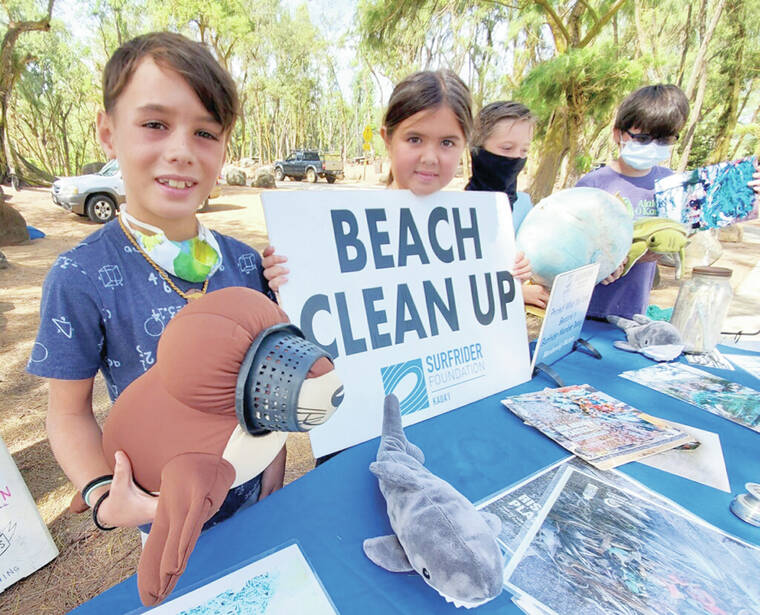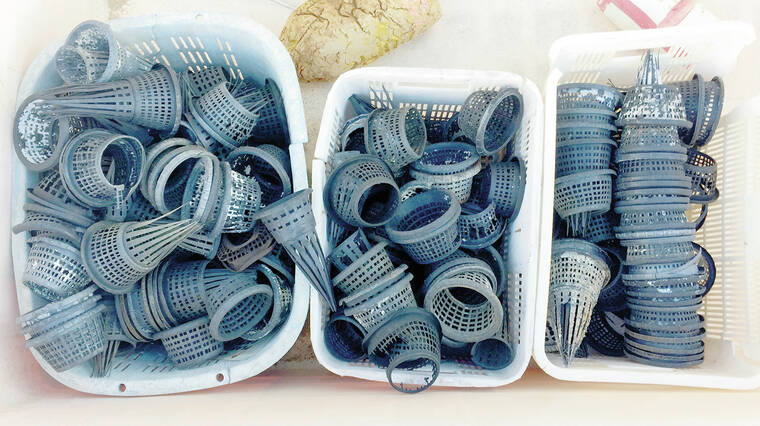LIHU‘E — Kaua‘i beachgoers are still needed in an international study of mysterious marine debris, three months after the nonprofit Surfrider Foundation announced its North Pacific Hagfish Trap Project.
Hagfish and conger eel trap entrances frequently wash ashore throughout Hawai‘i and are known to harm federally-endangered Hawaiian monk seals when caught on their snouts.
Surfrider staff knew little about the plastic, funnel-like devices, despite their prevalence.
“Here was something that we’ve never really identified. Initially, I didn’t even know what it was,” Carl Berg, senior scientist for Surfrider’s Kaua‘i chapter, said in a recent interview.
Berg, a key figure behind the Hagfish Trap Project, is no longer in the dark. Today, he knows the majority of trap entrances come from Korean, Japanese and Chinese fisheries, after months of research and collaboration with South Korea marine conservation group OSEAN. (Hawai‘i does not have a commercial hagfish or eel fishery. Eels seen in fish markets are usually caught by fishers seeking other species, according to Department of Land and Natural Resources Division of Aquatic Resources marine biologist Bryan Ishida.)
But the Hagfish Trap Project is only just gaining steam, as Surfrider begins to sift through thousands of traps taken in a combined effort to protect monk seals in the present and eliminate the problem at its source, in the future.
Surfrider says it can accomplish both goals if Hawai‘i community members become citizen scientists. It’s an easy role to fill: one need only snap a photo of a trap before disposing of it properly, to directly contribute to a scientific endeavor.
“What’s neat about this is, they’re collecting data, but they’re also being a part of the solution,” Surfrider Hawai‘i Regional Manager Lauren Blickley told The Garden Island. “By removing the traps from the beach, people are literally having an impact – that trap is not going to entangle a monk seal, a seabird or another type of marine animal.”
Blickley coordinates the Hagfish Trap Project throughout the Hawaiian Islands and the West Coast of the US mainland. But Kaua‘i’s location in the Pacific, she said, means it collects an outsize portion of marine debris originating from elsewhere in the ocean. In fact, Kaua‘i’s Surfrider chapter collects more marine debris than all other Surfrider chapters in the world, combined (Kaua‘i gathered approximately 70,000 pounds of marine debris in 2020, according to a graphic provided by Surfrider).
Hagfish and eel traps are more-easily identifiable than other debris generated by the global fishing industry, according to Blickley.
“It’s very hard to identify where these big net bundles are coming from – even if they’re coming from the same place,” she said. “But a hagfish or an eel trap … people have been pulling them up for over 20 years off of our beaches, and many people didn’t know what they were until we launched this project.”
Citizen scientists’ photos will be fed into an artificial intelligence program operated by the Computer Science Department of the University of Hawai‘i at Hilo. The AI will then analyze the digital images to identify distinguishing features like machine marks, text and more, before classifying the traps into groups.
This high-tech system will go a long way toward identifying the trap entrances’ countries of origin, manufacturers and users, according to Berg.
“It will help us understand how these trap entrances get floating around in the ocean,” he explained. “The trap may be a cylinder, or it may be a five-gallon bucket or it may be a 50-gallon barrel, depending on which country is doing the fishing. Somehow, it breaks off, or it is used or broken and thrown away … we don’t know.”
Surfrider will seek to educate fishers, if the traps that plague Hawaiian beaches are proven to be caused by widespread littering.
But if the debris is due to unintentional loss, Surfrider will approach fishers to design a more-durable, monk seal-friendly trap.
“How can we modify it, that if they’re lost they don’t get stuck?” Berg said. “That’s having something degradable. Using something that will break down, make the trap break into two pieces, so it’s not a cone anymore. Something like that.”
In the last 20 years, 13 Hawaiian monk seal pups and one yearling have been reported entangled by hagfish traps in the Northwestern Hawaiian Islands, according to Surfrider. Berg believes far more trap incidents have occurred, unseen by human eyes.
Submitting Photos
Consistency is key to the AI program’s success: each photo used by the UH-Hilo team must be taken from the same angle.
Berg finds positioning his camera to look straight down into a trap entrance captures more distinguishing features than any other single shot.
Photographers must also remember to position the trap on a white or very light surface – like sand – in order to highlight all of the trap’s perforations.
Once a beachgoer has snapped the perfect picture, they can email it to hagfish@surfrider.org.
“The whole idea is for us in Hawai‘i – especially on Kaua‘i, where we have had three monk seal pups born last year – to really go out and make sure that beaches are clean of these things,” Berg said. “Every (trap) that they take off, even if they take it off now, that’s one less that’s out there to hurt a monk seal pup next summer.”







